The Mental Aspects of the Handstand
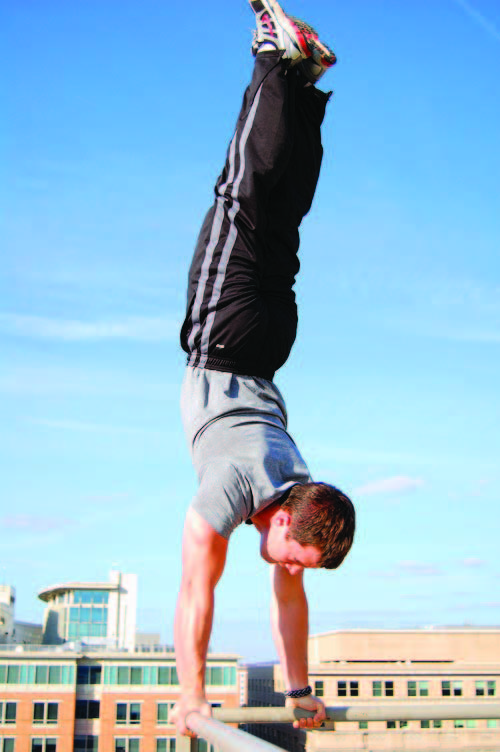
Exploring and developing the mental aspects of the handstand can help you develop more confidence and consistency. Call it “clutch,” or whatever you want, but focus and mental control can mean the difference between accomplishing-or not accomplishing- what you want when you want to.
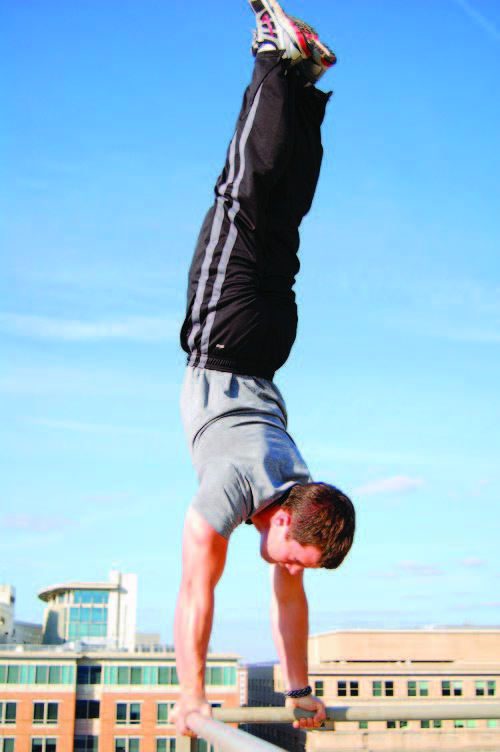
I’m taking the safe assumption that there are more weightlifters reading this article than acrobats, but I believe the things I’ve observed over the years in both my clients and myself can be applied to other areas of training. My own training involves more than just gymnastic work, so I’ll explain the relevance of each topic to various types of training.
I like to break down the mental aspects of the handstand into five different areas. The first is performing in front of other people. The second is becoming fearless of the exercise itself. Third is performing in different environments. Fourth is adding in variations. Fifth is the value of teaching to increase understanding and confidence. Each of these areas can come about naturally in your training over the years, but a dedicated effort to work on them can improve your “clutch” in any situation.
Handstands In Front Of People
If one routinely practices handstands alone, one avenue to develop confidence in the skill is to look for opportunities to perform in front of other people.
In both weight training and acrobatics, we may have our training partners and coaches routinely watch us during our workouts. Over time we become accustomed to, and perhaps even dependent upon, this gaze. We become comfortable. To develop further confidence, though, we need to find ways to make ourselves uncomfortable again.
I had the lucky opportunity to be part of Gymkana, an exhibitional gymnastic group, while I was in college. We performed handstands on various surfaces and situations in front of large groups of strangers.
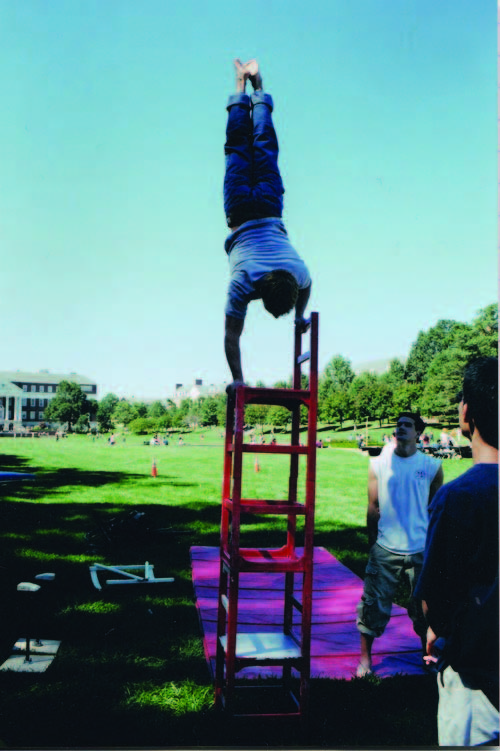
In another lifetime, I did a lot of breakdancing. If you’ve never been breaking before, the thought of jumping into the middle of a circle of strangers while performing athletically AND keeping a beat is absolutely terrifying.
Getting in front of your peers - other b-boys who actually know what they’re looking at (as opposed to drunken backspins at your cousin’s wedding) is even more frightening. Making it through these experiences made me more resilient to the discomfort of people watching. It also gave me greater confidence to perform the handstand in front of anyone.
Esteemed Bulgarian weightlifting coach Ivan Abadjiev stated in a lecture that his athletes would perform in front of an audience three times a week. Ivan continued with the belief that the near competitive atmosphere stimulates the release of adrenaline and makes the desired training mechanisms adapt. He acknowledges the importance of the emotional factor. You can read the whole translated lecture here.
One may wonder whether frequent weightlifting competitions would accomplish the same thing. I believe that competition is an excellent way to develop mental control, but competition every week is not feasible for many reasons. Abadjiev knew this, so he attempted to recreate the same uneasy feeling with his team on a more regular basis. You can try to recreate this in weightlifting with a larger group of training partners observing you, training at busier times with more gym-goers watching, or simply having an existing training partner sit in front of you, as a judge at a meet would do. Actively look for opportunities to perform in front of others and it will have less and less of a negative effect on you.
Handstands From Different Heights – Becoming Fearless
I thought about writing this article after seeing a segment on Eskil Ronningsbakken, an acrobat who performs death-defying balancing acts on cliff edges and mountaintops.
(You can see some absolutely astonishing handstand pictures on his website.)
On Stan Lee’s “Superhumans” show, Eskil was hooked up to a bunch of instruments that measured his stress levels. It was found that he was as calm and collected doing a handstand in the middle of a roof as he was on the edge of the roof. He was able to control his emotions and perform a stable handstand anywhere. Of course, Eskil didn’t start off on rooftops. He built up his superhuman control of fear by working on progressively harder and more dangerous feats.
Now, I don’t recommend anyone emulate Eskil’s feats. My girlfriend has definitely forbidden me from even thinking about it (the first picture of this article has a large rooftop underneath me), but what we can learn is that we should be practicing fearlessness with progressively more challenging exercises and weights. This is different than the fear of a crowd. This is the fear of total commitment to an exercise and the repercussions if one fails. If one never practices dealing with this fear, then one will never conquer it.
A take-home exercise to try today is to perform a handstand on a small platform. Even a small box can be daunting at first. Provided you can come down out of a regular handstand safely, the handstand on the small platform is not that much more dangerous, but will still provide you with an uncomfortable situation. You can then increase the height of the handstand based on your goals.
In my thoughts about handstands and different heights, I always think about the advice given to me when I was first learning a chair handstand up on high. “It’s just like a regular chair handstand, except higher.”
These words are eloquent in their simplicity, but there’s a message there. We focus so much on the repercussions (what if I fall/fail?!?) that we lose focus on the task at hand and it then becomes a self-fulfilling prophecy.
In a casual interview (with some choice words), weightlifting Champion Donny Shankle talks about the need to be fearless - - to try, to get knocked down again and again, but to never be afraid to get under that bar.
“A master is a person without fear,” he says.
View The Interview.
Practice being fearless. Fall down. Repeat.
Handstands In Different Environments
When I first taught myself a handstand, it was either outside in the grass or inside my small bedroom. Outside provided the challenge of uneven ground and a softer surface which made balancing harder. Inside provided the challenge of not kicking my nightstand. I had to be aware of my surroundings and control any fall. When I moved to practicing on a flat, open space-like a basketball court-it felt like a vacation.
Do you always practice your handstand in one spot? Have you ever tried practicing elsewhere? Do you know what the feeling of a handstand on asphalt feels like? How about grass? How about a sloped or irregular surface? How about the other subtle differences in lighting, temperature, and ambient noise?
This is probably the easiest handstand variation you can try: practicing your handstand in a different environment.
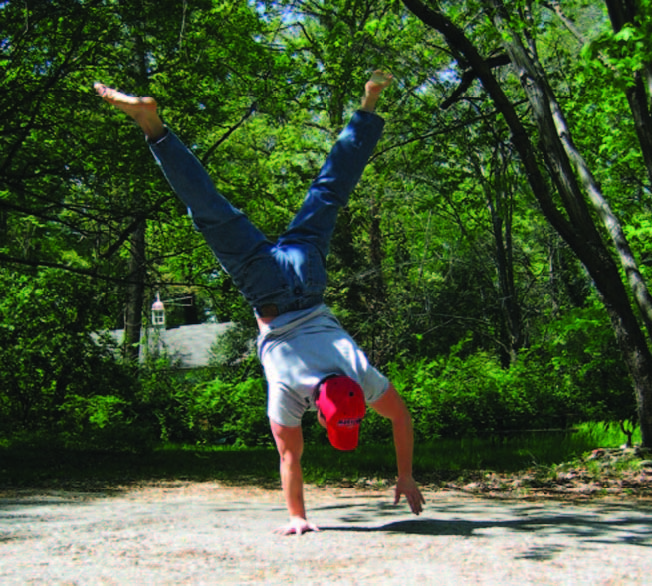
One arm handstand practice on my old driveway
A change in scenery can strengthen up your handstand by providing a stimulus that is “same, but different.” Although it’s the same exercise, the subtle or not-so-subtle differences of your environment will throw you off. But from this you can start to feel the commonalities among each handstand you do and internalize your technique. As this internalization gets stronger, the external environment and variations you encounter will affect you less and less.
This may not seem to matter to some, but I am amazed when something in my client’s environment changes (like practicing in a non-regular spot in the gym) and it results in difficulty in their technique for the first several attempts.
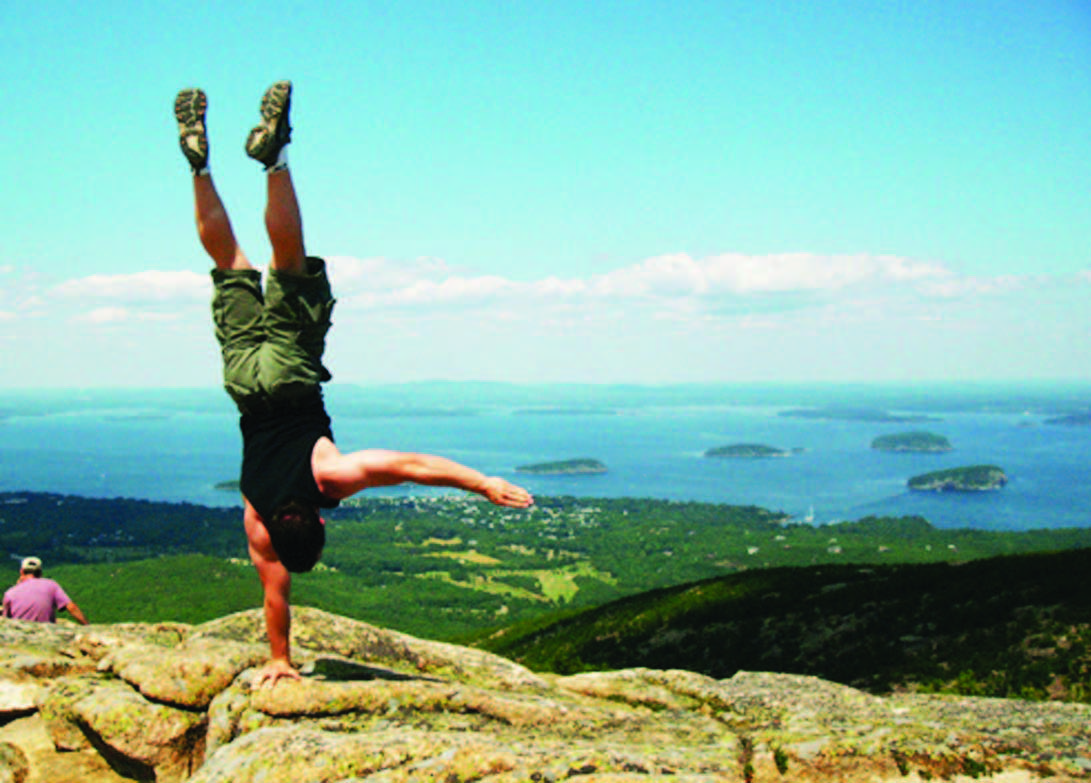
Cadillac Mountain, Acadia National Park, Maine
In the weightlifting world, everything needs to be honed and perfected in the predictable environment of a bar, plates and a platform. We are looking to lift and develop consistent technique with that equipment. What we can then do to apply this aspect is practice lifting on other platforms; visiting other gyms and getting into other atmospheres. If you’ve never lifted on a platform other than your own, then the unfamiliarity of new surroundings during a competition can throw you for a loop.
Visiting other gyms is a simple yet excellent idea, anyway. We are all part of a community that should already be traveling-exchanging ideas and stories with each other. Get in some lifting at other spots and soon you’ll be comfortable anywhere.
Again, while entering competitions can fulfill this exercise, visiting other gyms can be done on a more frequent basis in a more casual environment.
Different Types Of Handstands
On the same theory of “same, but different” and in order to understand your own handstand better, working variations of the handstand can allow you to see the similarities constant throughout. Is your weight balanced forward on your fingers? Is your body tight? Are your elbows straight?
A few of the infinite variations you can try include fingertip handstands, handstands on your fists, chair handstands or even walking in a handstand.
A quick disclaimer on handstand walking: Please make sure you are performing this variation with control. Staggering about in a handstand is not walking; it’s just an uncontrolled handstand. Work on better control and the ability to stay in place.
An old-time muscle beach tradition was partner acrobatic balancing – performing handstands and other such acrobatic moves with one or more people. Doing a handstand on someone, or supporting someone in a handstand, is much more difficult than it first appears!
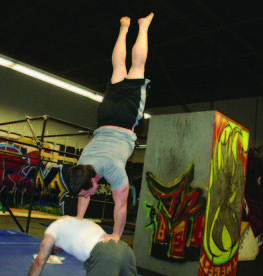
Handstand at Urban Evolution
Another challenging variation is to perform a blindfolded handstand. I’d like to bring to your attention to one Eddie Motter. He was a gymnast in the 50s that, despite being totally blind, was able to hold a handstand for over 3 minutes. –
View a video of my short handstand hold
In weightlifting, it’s true that we are not looking at how to proficiently clean or snatch anything other than a barbell. In powerlifting, it’s still squatting, benching, and deadlifting with just a barbell. I propose though that strongman and odd object lifting- deadlifting a stone, cleaning a keg, or pressing a log-can be fun and challenging variations that will actually help one understand the fundamentals of the lifts while giving a psychological break from only lifting a barbell (though it goes without saying that the basic clean and jerk and snatch should still occupy a large percentage of one’s Olympic weightlifting training).
Teach A Handstand
There’s the saying “when one person teaches, two people learn.” I’ve had the fantastic opportunity to make a living doing what I love–coaching full-time for the past 5 years. I have also been requested to give gymnastic seminars at numerous gyms, which allows me to see many problems and pitfalls that people have with their handstand. This gives me such a fantastic insight into the skill.
In order to be an effective coach, you have to be able to simplify the complex--to give just the key points that the athlete needs to hear at that moment: no more, no less.
By teaching others, we see the exercise from a different perspective. Technique problems that we never had, and probably never even considered, are somebody else’s bane.
This doesn’t mean that you need to coach athletes full-time yourself, but offering to watch and help someone’s technique in the weight room (if they are open to it) can help you in return. This back and forth exchange should be a normal part of everyone’s gym, but it’s not. How many of us have been to a gym where everyone is plugged into their headphones and no one helps anyone else? What community does that foster?
If you are still hesitant to teach, you can also observe a respected coach teaching. Watching him train and coach a fellow teammate can give you better insight into your sport. This improved knowledge will help improve your own technique and build your confidence.
Time
It needs to be said that excellent results in any skill takes time. Hard, consistent practice over years and years will always give you more confidence in your technique. I hope that you can speed up the process and explore areas you hadn’t considered with the techniques I’ve described.
The pictures used for this article were taken over a decade of practice. I’ve done more handstands in the past 10 years then I can even begin to count. I still have plenty of room for improvement, but I have enjoyed myself every step of the way.
So what is the ultimate culmination of all these variations? Of training your handstand so that the confidence in your ability is unwavering?
How about handstand walking in your underwear on asphalt in the winter in front of a crowd of people?
Never forget to have fun with your training.

I’m taking the safe assumption that there are more weightlifters reading this article than acrobats, but I believe the things I’ve observed over the years in both my clients and myself can be applied to other areas of training. My own training involves more than just gymnastic work, so I’ll explain the relevance of each topic to various types of training.
I like to break down the mental aspects of the handstand into five different areas. The first is performing in front of other people. The second is becoming fearless of the exercise itself. Third is performing in different environments. Fourth is adding in variations. Fifth is the value of teaching to increase understanding and confidence. Each of these areas can come about naturally in your training over the years, but a dedicated effort to work on them can improve your “clutch” in any situation.
Handstands In Front Of People
If one routinely practices handstands alone, one avenue to develop confidence in the skill is to look for opportunities to perform in front of other people.
In both weight training and acrobatics, we may have our training partners and coaches routinely watch us during our workouts. Over time we become accustomed to, and perhaps even dependent upon, this gaze. We become comfortable. To develop further confidence, though, we need to find ways to make ourselves uncomfortable again.
I had the lucky opportunity to be part of Gymkana, an exhibitional gymnastic group, while I was in college. We performed handstands on various surfaces and situations in front of large groups of strangers.

In another lifetime, I did a lot of breakdancing. If you’ve never been breaking before, the thought of jumping into the middle of a circle of strangers while performing athletically AND keeping a beat is absolutely terrifying.
Getting in front of your peers - other b-boys who actually know what they’re looking at (as opposed to drunken backspins at your cousin’s wedding) is even more frightening. Making it through these experiences made me more resilient to the discomfort of people watching. It also gave me greater confidence to perform the handstand in front of anyone.
Esteemed Bulgarian weightlifting coach Ivan Abadjiev stated in a lecture that his athletes would perform in front of an audience three times a week. Ivan continued with the belief that the near competitive atmosphere stimulates the release of adrenaline and makes the desired training mechanisms adapt. He acknowledges the importance of the emotional factor. You can read the whole translated lecture here.
One may wonder whether frequent weightlifting competitions would accomplish the same thing. I believe that competition is an excellent way to develop mental control, but competition every week is not feasible for many reasons. Abadjiev knew this, so he attempted to recreate the same uneasy feeling with his team on a more regular basis. You can try to recreate this in weightlifting with a larger group of training partners observing you, training at busier times with more gym-goers watching, or simply having an existing training partner sit in front of you, as a judge at a meet would do. Actively look for opportunities to perform in front of others and it will have less and less of a negative effect on you.
Handstands From Different Heights – Becoming Fearless
I thought about writing this article after seeing a segment on Eskil Ronningsbakken, an acrobat who performs death-defying balancing acts on cliff edges and mountaintops.
(You can see some absolutely astonishing handstand pictures on his website.)
On Stan Lee’s “Superhumans” show, Eskil was hooked up to a bunch of instruments that measured his stress levels. It was found that he was as calm and collected doing a handstand in the middle of a roof as he was on the edge of the roof. He was able to control his emotions and perform a stable handstand anywhere. Of course, Eskil didn’t start off on rooftops. He built up his superhuman control of fear by working on progressively harder and more dangerous feats.
Now, I don’t recommend anyone emulate Eskil’s feats. My girlfriend has definitely forbidden me from even thinking about it (the first picture of this article has a large rooftop underneath me), but what we can learn is that we should be practicing fearlessness with progressively more challenging exercises and weights. This is different than the fear of a crowd. This is the fear of total commitment to an exercise and the repercussions if one fails. If one never practices dealing with this fear, then one will never conquer it.
A take-home exercise to try today is to perform a handstand on a small platform. Even a small box can be daunting at first. Provided you can come down out of a regular handstand safely, the handstand on the small platform is not that much more dangerous, but will still provide you with an uncomfortable situation. You can then increase the height of the handstand based on your goals.
In my thoughts about handstands and different heights, I always think about the advice given to me when I was first learning a chair handstand up on high. “It’s just like a regular chair handstand, except higher.”
These words are eloquent in their simplicity, but there’s a message there. We focus so much on the repercussions (what if I fall/fail?!?) that we lose focus on the task at hand and it then becomes a self-fulfilling prophecy.
In a casual interview (with some choice words), weightlifting Champion Donny Shankle talks about the need to be fearless - - to try, to get knocked down again and again, but to never be afraid to get under that bar.
“A master is a person without fear,” he says.
View The Interview.
Practice being fearless. Fall down. Repeat.
Handstands In Different Environments
When I first taught myself a handstand, it was either outside in the grass or inside my small bedroom. Outside provided the challenge of uneven ground and a softer surface which made balancing harder. Inside provided the challenge of not kicking my nightstand. I had to be aware of my surroundings and control any fall. When I moved to practicing on a flat, open space-like a basketball court-it felt like a vacation.
Do you always practice your handstand in one spot? Have you ever tried practicing elsewhere? Do you know what the feeling of a handstand on asphalt feels like? How about grass? How about a sloped or irregular surface? How about the other subtle differences in lighting, temperature, and ambient noise?
This is probably the easiest handstand variation you can try: practicing your handstand in a different environment.

One arm handstand practice on my old driveway
A change in scenery can strengthen up your handstand by providing a stimulus that is “same, but different.” Although it’s the same exercise, the subtle or not-so-subtle differences of your environment will throw you off. But from this you can start to feel the commonalities among each handstand you do and internalize your technique. As this internalization gets stronger, the external environment and variations you encounter will affect you less and less.
This may not seem to matter to some, but I am amazed when something in my client’s environment changes (like practicing in a non-regular spot in the gym) and it results in difficulty in their technique for the first several attempts.

Cadillac Mountain, Acadia National Park, Maine
In the weightlifting world, everything needs to be honed and perfected in the predictable environment of a bar, plates and a platform. We are looking to lift and develop consistent technique with that equipment. What we can then do to apply this aspect is practice lifting on other platforms; visiting other gyms and getting into other atmospheres. If you’ve never lifted on a platform other than your own, then the unfamiliarity of new surroundings during a competition can throw you for a loop.
Visiting other gyms is a simple yet excellent idea, anyway. We are all part of a community that should already be traveling-exchanging ideas and stories with each other. Get in some lifting at other spots and soon you’ll be comfortable anywhere.
Again, while entering competitions can fulfill this exercise, visiting other gyms can be done on a more frequent basis in a more casual environment.
Different Types Of Handstands
On the same theory of “same, but different” and in order to understand your own handstand better, working variations of the handstand can allow you to see the similarities constant throughout. Is your weight balanced forward on your fingers? Is your body tight? Are your elbows straight?
A few of the infinite variations you can try include fingertip handstands, handstands on your fists, chair handstands or even walking in a handstand.
A quick disclaimer on handstand walking: Please make sure you are performing this variation with control. Staggering about in a handstand is not walking; it’s just an uncontrolled handstand. Work on better control and the ability to stay in place.
An old-time muscle beach tradition was partner acrobatic balancing – performing handstands and other such acrobatic moves with one or more people. Doing a handstand on someone, or supporting someone in a handstand, is much more difficult than it first appears!

Handstand at Urban Evolution
Another challenging variation is to perform a blindfolded handstand. I’d like to bring to your attention to one Eddie Motter. He was a gymnast in the 50s that, despite being totally blind, was able to hold a handstand for over 3 minutes. –
View a video of my short handstand hold
In weightlifting, it’s true that we are not looking at how to proficiently clean or snatch anything other than a barbell. In powerlifting, it’s still squatting, benching, and deadlifting with just a barbell. I propose though that strongman and odd object lifting- deadlifting a stone, cleaning a keg, or pressing a log-can be fun and challenging variations that will actually help one understand the fundamentals of the lifts while giving a psychological break from only lifting a barbell (though it goes without saying that the basic clean and jerk and snatch should still occupy a large percentage of one’s Olympic weightlifting training).
Teach A Handstand
There’s the saying “when one person teaches, two people learn.” I’ve had the fantastic opportunity to make a living doing what I love–coaching full-time for the past 5 years. I have also been requested to give gymnastic seminars at numerous gyms, which allows me to see many problems and pitfalls that people have with their handstand. This gives me such a fantastic insight into the skill.
In order to be an effective coach, you have to be able to simplify the complex--to give just the key points that the athlete needs to hear at that moment: no more, no less.
By teaching others, we see the exercise from a different perspective. Technique problems that we never had, and probably never even considered, are somebody else’s bane.
This doesn’t mean that you need to coach athletes full-time yourself, but offering to watch and help someone’s technique in the weight room (if they are open to it) can help you in return. This back and forth exchange should be a normal part of everyone’s gym, but it’s not. How many of us have been to a gym where everyone is plugged into their headphones and no one helps anyone else? What community does that foster?
If you are still hesitant to teach, you can also observe a respected coach teaching. Watching him train and coach a fellow teammate can give you better insight into your sport. This improved knowledge will help improve your own technique and build your confidence.
Time
It needs to be said that excellent results in any skill takes time. Hard, consistent practice over years and years will always give you more confidence in your technique. I hope that you can speed up the process and explore areas you hadn’t considered with the techniques I’ve described.
The pictures used for this article were taken over a decade of practice. I’ve done more handstands in the past 10 years then I can even begin to count. I still have plenty of room for improvement, but I have enjoyed myself every step of the way.
So what is the ultimate culmination of all these variations? Of training your handstand so that the confidence in your ability is unwavering?
How about handstand walking in your underwear on asphalt in the winter in front of a crowd of people?
Never forget to have fun with your training.
| Jim Bathurst runs BeastSkills.com, a website that provides progressive tutorials for difficult bodyweight exercises. His gymnastics seminars have been requested internationally. Despite his reputation for bodyweight expertise, he enjoys barbell lifting tremendously and competes in Powerlifting and Olympic lifting. His best lifts are respectable, depending on what gym he is in. |
Search Articles
Article Categories
Sort by Author
Sort by Issue & Date
Article Categories
Sort by Author
Sort by Issue & Date

